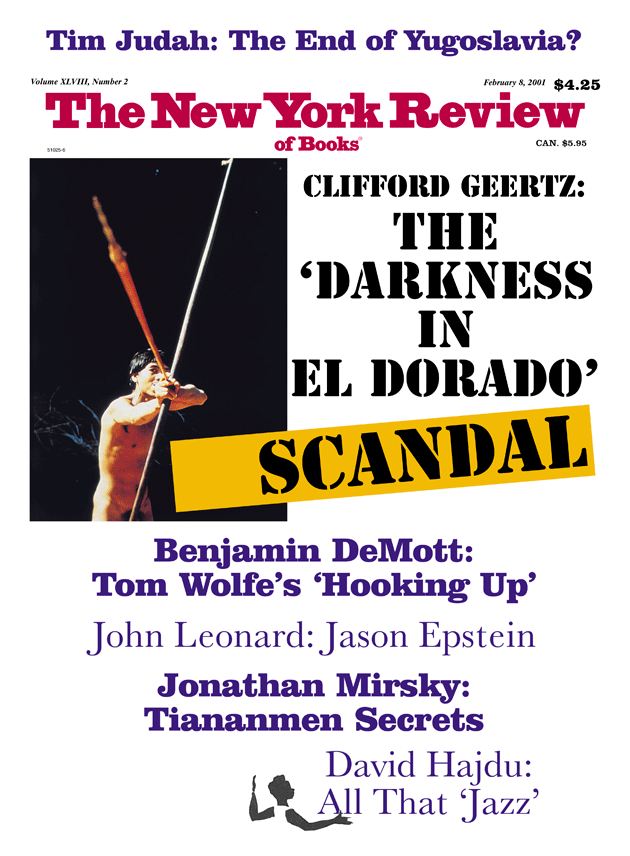I don’t mind criticism. But in his review of my book Day of Deceit [NYR, November 2, 2000], David Kahn makes some crucial errors while mistakenly accusing me of the same. His case—that the Pearl Harbor attack was a surprise, and that revisionists like me who say otherwise are all wrong—rests on the question of radio silence. Did the Japanese fleet maintain strict radio silence, as traditionally has been argued? Or did we intercept messages, which—whether decoded or not—would have alerted us that the senders were advancing eastward? Corrections of Kahn’s mistakes are in order before anyone dismisses my “most irrational” book. I will limit myself to two.
(1) I cite the US Navy intelligence summary of November 25, 1941 (Hawaii Time), which reports Japan’s naval messages that were originated November 26, Tokyo Time. The summary supports the fact that the commanders of the three Japanese forces aimed at Hawaii broke radio silence and held extensive radio communications between themselves. Kahn asserts, “The summary says not what [I] claim it does, only that ‘Fourth Fleet is still holding extensive communications with the Commander Submarine Fleet.’ It refers in no way and in no place to any messages from any forces heading toward Hawaii.” Here is the full relevant quote from the intelligence summary: “CinC [i.e., Commander in Chief] Fourth Fleet is still holding extensive communications with the Commander Submarine Fleet, the forces at Jaluit and Commander Carriers.” It is important to remember, as perhaps Kahn did not, that this summary refers to messages transmitted on November 26, Tokyo Time. On that date, Japan’s carrier force of thirty-three warships set sail into the North Pacific, heading for Pearl Harbor. The key “Commander Carriers” was Vice Admiral Chuichi Nagumo, aboard the aircraft carrier Akagi, who was the commander of that force. This summary message thus reports that Nagumo was in radio contact with the commander in chief of Japan’s Central Pacific Forces as well as the commander of Japan’s submarine fleet (who was aboard his flagship, leading thirty submarines as part of the attack force).
(2) I cite the intelligence summary of December 6, Hawaii Time, which reports Japanese naval messages transmitted December 6–7, 1941 (Tokyo Time), as just one more of many pieces of evidence that the attack force was addressed in radio messages. Kahn accurately quotes me as writing that Japanese commander in chief Admiral Isoroku Yamamoto “originated several [radio] messages to the Carriers.” He goes on to say, “The summary he cites mentions no such messages.” Here is the relevant quote from the summary of the 6th: “The Commander in Chief Combined Fleet originated several messages to the Carriers, Fourth Fleet and the Major Commanders.” Perhaps Kahn didn’t realize that I was referring to Tokyo’s dates for Yamamoto’s messages, and he looked up the wrong summary. In any event this summary clearly shows message traffic prior to the attack—as do many, many other pieces of evidence in my book.
There are other major disagreements between us, including over whether or not we were reading any of the Japanese naval coded messages prior to the attack. Kahn says we weren’t. But I cite a great deal of evidence that we were; readers may judge for themselves. Let me add one more: since the book was published, a document has surfaced in which Lieutenant John M. Lietwiler reported to the Navy on November 16, 1941, that his cryptographers on Corregidor were “current” in intercepting, decoding, and translating Japanese naval messages. Which one of us is “refusing to admit that we can be in error?”
Robert B. Stinnett
Oakland, California
David Kahn replies:
Mr. Stinnett states that “The summary [of November 25] supports the fact that the commanders of the three Japanese forces aimed at Hawaii broke radio silence and held extensive radio communications among themselves.” It supports no such thing. My quotation of the original—as with much else that was condensed for the review—omitted the last seven words of the first sentence of the Fourth Fleet section, which reads in full: “CinC, Fourth Fleet is still holding extensive communications with the Commander Submarine Fleet, the forces at Jaluit and Commander Carriers. His other communications are with the Third, Fourth and Fifth Base Forces.” The force that attacked Hawaii was not that of the Commander Carriers but the First Air Fleet. US Navy codebreakers had discovered it on November 3, but they do not mention it in the November 25 or later summaries as either a sender or receiver of messages.
In his letter, Mr. Stinnett refers to the summary of December 6, but in his book he cites the summary of December 5, which, as I said in the review, mentions no messages to aircraft carriers. The summary of December 6 states, “The Commander in Chief Combined Fleet originated several messages to the Carriers, Fourth Fleet and the Major Commanders.” This likewise does not refer to the First Air Fleet.
John Lietwiler’s letter of November 16, 1941, to a naval cryptanalyst in Washington expresses discontent with what appears to be a mechanical aid, called the Jeep IV, for stripping the superencipherment from a code, which is not specified. It further states, “We are reading enough current traffic to keep two translators very busy, with their code recovery efforts, etc. included. In this connection, I certainly wish you could see your way clear to drop the ancient history of this cipher and work with us on each current system as it comes up.” Whatever Lietwiler is discussing, it is clearly not the Imperial Japanese Navy’s main, currently used naval cryptosystem, JN 25 B, and the letter in no place and in no way refers to or suggests a reference to either the First Air Fleet or Pearl Harbor.
This Issue
February 8, 2001


